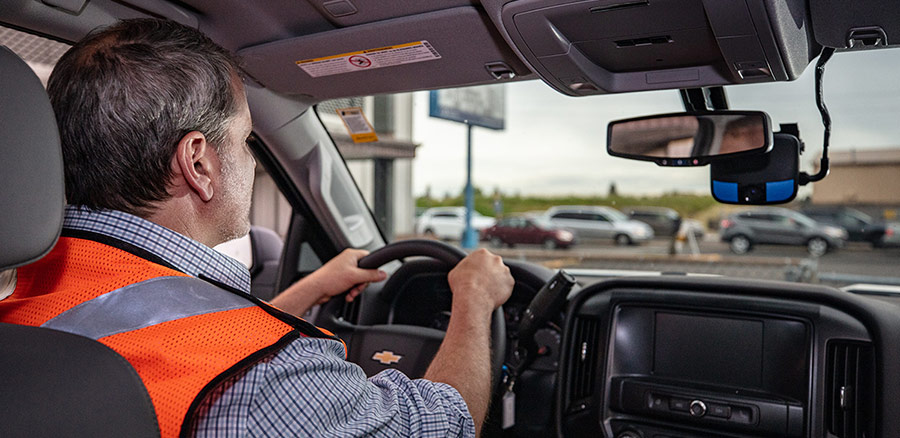Overcoming Trust Issues with Vehicle Cameras

It’s understandable that some drivers show hesitation when fleets introduce vehicle cameras. Many drivers may assume their every move will be recorded, but that’s not the case. Fleets use video as a tool to improve performance and—most importantly—to protect drivers and the business if the worst happens.
Need help gaining buy-in? Here are three powerful facts that can help fleets get drivers to trust vehicle cameras:
1. Vehicle cameras are the new norm
Vehicle cameras, more colloquially known as fleet dash cams, gained fame for documenting dramatic police activities and meteors hurtling across the sky. But what used to be cutting-edge electronics have become mainstream—cameras are the new norm for both commercial and private vehicles. In 2018, the global market size for dashboard cameras was $2.58B USD; it’s projected to increase by nearly a billion ($3.50B) in 2020, and grow between $1.84B and $5.3B by 2022.
The proliferation of vehicle cameras is largely due to technology advancements. Being able to record high-quality video with tiny, unobtrusive cameras and save footage in vast cloud storage spaces, all at an affordable cost, has made vehicle cameras attractive to both consumers and businesses.
While there’s no question that more and more commercial fleets are installing vehicle cameras, they aren’t alone. Aside from police forces, vehicle cameras are increasingly found in transit buses, school buses, ride-share cars, and more. The primary motivation? Protection. Cameras are helping drivers protect themselves against passengers and nearby vehicles making poor decisions.
Not to mention, consumer demand for in-car and exterior monitoring systems is skyrocketing. Google’s 2018 Automotive Trends Report found that searches for vehicle cameras are trending across all markets. In fact, search volume for onboard cameras is triple the search volume for autonomous driving. Car manufacturers are responding by building next-generation technology that includes features such as 360-degree views that record the road ahead and seamlessly integrate into car dashboards, as well as facial recognition software to help prevent theft and drunk driving.
The one big question to ask drivers is: “If every private vehicle is going to include onboard cameras, shouldn’t commercial fleets be similarly equipped?” For protection and safety, if nothing else, it’s critical for commercial fleets to incorporate cameras into their vehicles.
2. Vehicle cameras have benefits for drivers
Fleet managers and coaches can encourage drivers to buy-in to vehicle cameras by explaining these benefits:
Protection
Video provides clear evidence of what really happened during an incident or collision. This helps exonerate drivers from false claims and expensive legal quagmires that could put their jobs in jeopardy. Drivers won’t have to worry about “he said, she said” situations ever again.
Input
Drivers want their feedback and ideas to be heard, but communication can be tough when most days are spent out in the field. Bringing video from vehicle cameras into coaching sessions opens up channels of dialog. Drivers can share their input—a “boots on the ground” perspective of what it’s actually like on the road—and engage with coaches as partners in problem solving. Feedback becomes a two-way street, with clear footage to support conversation topics like defensive driving, fleet safety procedures, and service best practices.
Rewards
Cameras are unbiased—they don’t just capture risky situations, but also smart, safe driving behaviors. One of the most effective driver retention tactics is to acknowledge a job well done and that’s much easier for fleets to do using the objective data from video. Drivers can earn rewards for exhibiting or improving safe driving behaviors and performance (such as minimizing idling or downtime), which incentivizes a safety culture.
3. Fleet technology makes drivers’ jobs easier
What many drivers may not realize is that vehicle cameras are just one part of a full fleet management solution. In addition to video, modern telematics systems typically include engine control modules, advanced driver assistance systems, electronic logging devices, and GPS fleet tracking. In other words, fleets are installing vehicle cameras not as watchdogs, but as performance accelerators.
Fleet technology can help automate and streamline elements of the job that have been daily frustration points for drivers. For example, fleet solutions with video telematics can:
- Optimize routes to avoid traffic and delays
- Provide more accurate service updates to customers to combat complaints and issues
- Improve vehicle maintenance processes to keep more trucks in the field, in better shape
- Get data and insights that predict the most likely outcomes of common “on the road” scenarios
- Streamline dispatch operations so drivers are deployed in the most efficient manner
It’s no secret that vehicle cameras make some drivers nervous, but video is becoming essential for the safety and protection of drivers and fleets themselves. With proper education and communication, fleets can overcome doubts about vehicle cameras to win the trust of all employees.
To learn more about the benefits of video telematics for your fleet, contact us.
